|
After winning
the 2004 SuperSport category of the P1 World Championship,
Marco Pennesi, driver and owner of Team Speedbuster and the
shipyard Metamarine, chose to move up to the Evolution
category in 2005, with a new boat, designed and built by him
specifically to compete in P1.
The
Evolution Class is open to boats with a minimum length of
36ft and maximum of 43ft using inboard motors only and with
a minimum post-race weight of 4250 kg. Whilst these high
powered prototype racing craft can reach speeds in excess of
100mph (equivalent of more than 200mph on land), the rules
demand a power to weight ratio of 1hp to 3.5kg with a
maximum average lap speed of 87mph and top speed of 95mph to
ensure safe and competitive racing. Pennesi's new Evolution
Class boat, called Fainplast, experienced some technical
problems during the season convincing him to consider
developing even some of the mechanical components including
the drive surface system, propellers, gear boxes and flaps.
He and his team spent all winter building and testing new
technical elements and when, at the end of May, Fainplast
was considered ready for action, with the exception of the
engine the craft had been completely built by the Metamarine
shipyard.
Winning in a
championship as competitive as Powerboat P1 is not easy, it
requires great skill and courage and like all top level
motorsport is fraught with danger. During testing on the
morning of the Grand Prix of Italy, the second round of the
2006 Powerboat P1 Offshore World Championship, Fainplast
turned over whilst practicing a high speed turn and sank.
Thankfully, pilots Marco Pennesi, Ernesto Ascani and Luigi
Bisceglia were not injured in the accident but there was
great despair throughout the team as they reflected on all
the hard work that had already been invested and the time
and money now required repairing the boat.
Unable to
compete in the second leg of the race, within 24 hours of
the incident, the boat was back at the teamís shipyard and
the hard work commenced. This highly motivated and
determined team spent the whole of June - day and night-
working on the boat to ensure that it would be ready in time
for the next event, the German Grand Prix, the third round
of the series, which took place on 02-03 July. They
dismounted and remounted the engines, the gears, the
transmission and changed all the electrical components and
instruments damaged in the sinking. Fortunately the
structure of the boat is very strong and required no further
care.
|
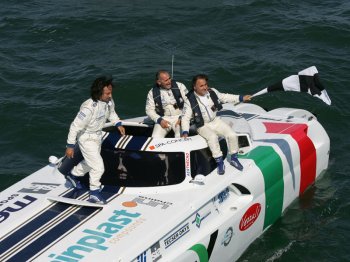 |
|
Marco Pennesi, Ernesto
Ascani and Luigi Bisceglia celebrate a superb win
for the Fainplast boat in the German Grand Prix held
earlier this month. |
|
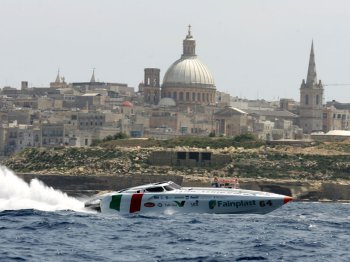 |
|
Team Speedbuster
claimed a third place finish in race two of the
opening Grand Prix of the 2006 Powerboat P1 season
at Valetta in Malta during May. |
|
|
 |
|
In Germany earlier this
month, Team Speedbuster was rewarded for all
their hard work in the best possible way, winning
the second leg of the German Grand Prix in Travemunde with a highly impressive performance. |
|
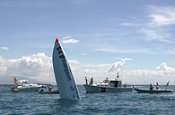 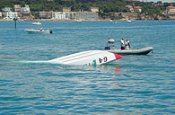
 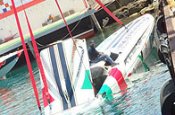 |
|
During testing on the morning of the Grand Prix of
Italy, the second round of the 2006 Powerboat P1
Offshore World Championship, Fainplast turned over
whilst practicing a high speed turn and sank. |
|
|
In Germany, the team was rewarded for all their hard work in
the best possible way, winning the second leg of the German
Grand Prix in Travemunde with a highly impressive
performance. Now they hope to repeat the result in the next
race which takes place in eight days time, the Grand Prix of
the Mediterranean, in Gallipoli, not far from Metamarineís
home base in San Benedetto del Tronto.
The ancient
Southern Italian city of Gallipoli lies south of the baroque
citadel of Lecce and is not to be confused with the area of
the Dardanelle peninsula in Turkey that bears the same name
and which witnessed one of the bloodiest battles of the
First World War. Located on the 'heel' of the 'boot' formed
by the Italian coastline Gallipoli has a medieval centre on
an island with its own natural harbour that is linked to the
modern town by a long stone bridge.
Gallipoli is a
city with ancient Greek origins that are reflected in its
name, which is derived from 'kale polis' - the Greek words
for lovely town. In its more than 2000 year history the city
was also an important Roman municipum and a stronghold
against invading Norman forces during the Byzantine period.
Historic and artistic treasures to be found in modern day
Gallipoli include the beautiful baroque cathedral of Sant'
Agata, the white church of the Purita and the Church of St
Francis of Assisi. The city is also notable for the narrow
lanes and balconied houses of its historic centre, it's
footpaths scented with juniper and myrtle winding through
rocks to soft, sandy beaches and its turquoise sea.
In addition
Gallipoli is a gastronomic delight, with numerous
restaurants offering local specialities in particular fresh
fish and other seafood, and has a vibrant nightlife. When
the Powerboat P1 World Championship comes to town in July
competitors, officials and spectators alike will receive a
warm welcome from the city known as the 'The Pearl of the
Ionian Sea'.
|
|
|
|